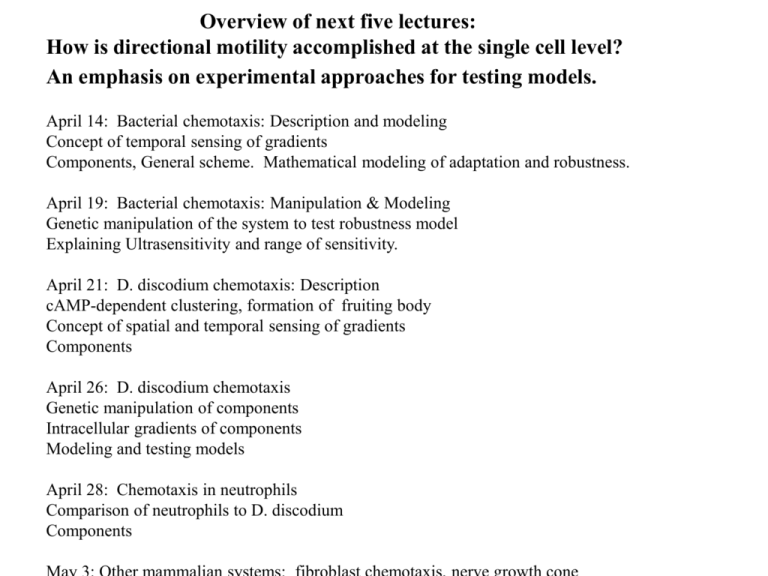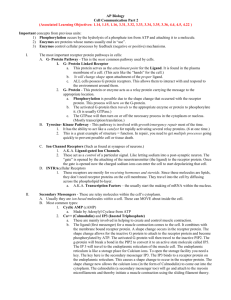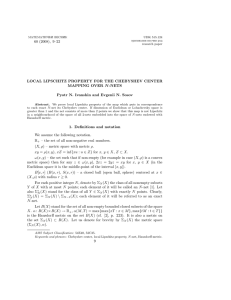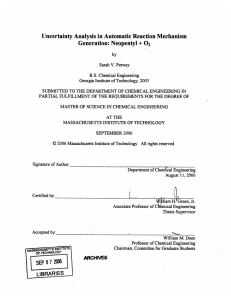CantleySBLect1
advertisement

Overview of next five lectures: How is directional motility accomplished at the single cell level? An emphasis on experimental approaches for testing models. April 14: Bacterial chemotaxis: Description and modeling Concept of temporal sensing of gradients Components, General scheme. Mathematical modeling of adaptation and robustness. April 19: Bacterial chemotaxis: Manipulation & Modeling Genetic manipulation of the system to test robustness model Explaining Ultrasensitivity and range of sensitivity. April 21: D. discodium chemotaxis: Description cAMP-dependent clustering, formation of fruiting body Concept of spatial and temporal sensing of gradients Components April 26: D. discodium chemotaxis Genetic manipulation of components Intracellular gradients of components Modeling and testing models April 28: Chemotaxis in neutrophils Comparison of neutrophils to D. discodium Components How do bacteria decide where to go? QuickTime™ and a Sorenson Video decompressor are needed to see this picture. Salmonella typhimurum Qu i c k T i m e ™ a n d a T IF F (U n c o m p r e s s e d ) d e c o m p re s s o r a re n e e d e d to s e e th i s p i c t u re . Chemotaxis toward serine Chemotaxis away from phenol From B.A. Rubik and D.E. Koshland, PNAS 75:2820-2824, 1978 Complex behavior in a uniform mixture of two chemoattractants http://www.aip.org.pt/jan00/berg.htm How do Eukaryotic cells know where to go? QuickTime™ and a Video decompressor are needed to see this picture. Neutrophil chasing a bacterium: Stossel, 1999 QuickTi me™ a nd a None decompre ssor are need ed to se e th is p icture. Neutrophil chasing a pipet Visualization of E. coli flagella with GFP fusion protein (from Berg lab) QuickTime™ and a Cinepak decompressor are needed to see this picture. Real time QuickTime™ and a Cinepak decompressor are needed to see this picture. Slowed down <http://www.rowland.harvard.edu/labs/bacteria/index_movies.html E. Coli anchored via flagella reveals switching between clockwise and counter-clockwise rotation (from Berg lab) QuickTime™ and a Cinepak decompressor are needed to see this picture. <http://www.rowland.harvard.edu/labs/bacteria/index_movies.html Mysteries of bacterial chemotaxis 1. Bacteria cannot sense direction directly and can only decide whether to go straight or to stop and randomly chose a new direction - yet they end up over time at the location of the highest concentration of chemoattractant. How does this happen? Mysteries of bacterial chemotaxis 2) Bacteria can respond to small differences (<1% front to back) in chemoattractant concentration over a very large (1000 fold) range of basal concentrations. Given what we know about receptor saturation, how can this work? Inconsistent with simple hyperbolic 990-1000 or sigmoidal saturation of receptor binding 9.9-10 99-100 A B C D Receptor Occupation E F AB EF CD [Attractant] Mysteries of bacterial chemotaxis 3) Bacteria demonstration perfect adaptation: When acutely given a uniform concentration of a chemotactic agent, they decrease their tumbling frequency within seconds but after several minutes return to the exact same tumbling frequency as before addition of chemotactic agent. A second jump to yet a higher concentration of chemotactic agent elicits an idential response. 3B) Adaptation is Robust: Large changes in the concentrations of the components of the adaptation system affect the time required to adapt but do not interfere with perfect adaptation. Observations Bacteria move towards attractants A bacterium senses differences in concentration with time rather than differences from one end of the bacterium to the other (<1 mm). Bacteria run (straight line) then tumble (random reorientation). In a linear gradient of chemoattractant, a 0.2 % difference over 1 mm length of bacterium becomes a 4% difference over a 20 mm run. By comparing receptor occupancy at 30 sec to occupancy at time 0, the bacterium can decide whether it is running in the right direction. Run = coordinated counterclockwise flagellar rotation Tumble = uncoordinated clockwise flagellar rotation Increasing [attractant] -> rarer tumbling -> net movement up gradient. Other considerations: Brownian drift (thermal collisions with water, solutes, macromolecules) alters course from straight line during run. Periodic tumbling ultimately insures that the steepest path up the chemotactic gradient is ultimately taken. Bacteria have no significant momentum in a given direction. When flagellar rotation is switched to clockwise they ‘stop on a dime’. Adaptation Alon, U., et al. (1999). Nature 397: 168-71. Bacteria rapidly reduce the frequency at which they tumble in response to elevation of attractant but in the presence of high constant attractant concentration, they invariably return to the original tumbling frequency (within 1%). This adaptation time is variable. Mutational approaches to tease out genes mediating chemotaxis Plate contains serine and aspartate Wild type Looking for Asp (2nd choice) Looking for Ser (1st choice) Non-motile flg Ser detection- tsr Asp detection- tar http://www.aip.org.pt/jan00/berg.htm Mutant classes Lack flagella: flg, flh, fli, flj Non-motile: mot General chemotaxis block: che (A, B, R, W, Y, Z) Specific chemotaxis block: tsr, tar, etc. Structure of the machinery 1 http://www.aip.org.pt/jan00/berg.htm Rotary 8 cylinder motor driven by protonmotive force (400 steps/rev) Structure of the machinery 2 Alberts et al. Mol Biol Cell 3rd Ed. Structure of the machinery 3 Counter-Clockwise = straight swim, bundled flagella Clockwise = tumble, separate flagella CheY-P binding to motor -> CW rotation Repellent -> CheA-P -> CheY-P -> CW Attractant -> CheA-P -> CheY-P -> CW Alberts et al. Mol Biol Cell 3rd Ed. Falk and Hazelbauer (2001) TIBS 26, 257 Two levels of receptor regulation Attractant binding -> Lower activity Methylation -> Higher activity Feedback produces adaptation Attractant binding reduces the fraction of active receptors, reduces phosphorylation of the demethylase, CheB and ultimately leads to a net increase in receptor methylation. Since methylated receptors are active even when attractant is bound, the activity is ultimately restored to normal Acute removal of attractant increases the activity of the receptors but ultimatley triggers demethylation and reduces activity to normal. Simplified adaptation model with the key assumption that CheB can only demethylate the active form of the receptor/kinase complex. In this model, when fewer receptors are active due to an acute increase in ligand binding, CheB has less substrate available so demethylation is slowed while methylation (CheR) is constant resulting in a net increase in receptor methylation over the next few minutes. Since methylation stabilizes the activation state of the receptor (even when ligand is bound), the net activation ultimately returns to the original value. This model argues that availability of “active” receptor substrate for CheB is more important for perfect adaptation than is the phosphorylation state (activity) of CheB. Barkai&Leibler 1997 Naure 387, 913 In the absence of ligand, the activity of the system at steady state can be defined by: Ast = aE + amEm = medium Where E and Em are the concentrations of unmethylated and methylated receptors, a is the probability that the unmodified receptor is in the active state and am is the probability that the methylated receptor is in the active state. In general am is much higher than a (indicated by size of symbol) so most activity is due to the methylated receptors. The activity of the system immediately after addition of saturating ligand (all receptors bound to ligand) is defined by A(l): A(l) = a(l)E + am(l)Em = low Where a(l) is the probability that the unmodified receptor (ligand bound) is in the active state and am(l) is the probability that the methylated receptor (ligand bound) is in the active state. In general a(l) and am(l) are smaller than a and am (indicated by size of symbols) and the ratio of Em to E does not change in the initial seconds after ligand addition due to the slow rate of methylation/demethylation so ligand binding causes an acute drop in activity. However, since CheB can only act on active Em, and less Em is active, demethylation is reduced while methylation continues, shifting to a higher ratio of Em to E, reaching a new steady state that has the same activity (but different E/EM ratio) as the original: A(l)st = a(l)E + am(l)Em = medium = Ast For simplicity, assume a = 0 (e.g. only the methylated receptor can be active under any condition) and assume CheR is saturated, then the rate of change in the methylated form of E is: dEm/dt = VRmax - VBmax(A)/(Kb+A) Where Kb is the Michaelis constant for interaction of the activated form of Em (e.g. A) with CheB. VRmax and VBmax are the maximal rates of CheR and CheB respectively. VBmax is assumed to be greater than VRmax. When dEm/dt = 0 (steady state), then: Ast = KbVRmax/(VBmax-VRmax) = am(l)Estm Notice that this equation is only dependent on parameters reflecting the activities of CheR and CheB and the Michaelis constant for CheB. Thus, regardless of the perturbation due to binding of ligand, the system will reset to the same steady state (e.g. If am(l) is 1/10 of am then Estm will increase 10 fold to compensate). Assumptions in Baraki&Leibler adaptation model: 1. Ligand binding is rapid compared to methylation/demethylation and for simplicity (not necessary for conclusions), ligand binding affinity is the same for all forms of methylated and unmethylated forms of the receptor. 2. CheB can only demethylate active receptors and the rate of demethylation is independent of the methylation state or ligand binding state of the receptor and independent of the phosphorylation state of CheB itself. 3. CheR can methylate both active and inactive receptors, whether or not ligand is bound. For greater simplicity it can also be assumed that CheR is saturated by substrate and methylates all receptors at the same rate and this does not affect the general conclusion. Assumptions in Baraki&Leibler adaptation model: Notice that the ability of active receptors to cause phosphorylation of CheB and inactivate CheB is not considered in this model (VBmax is treated as a constant). Thus, this regulation is not required for perfect adaptation. If considered, this regulation would be predicted to increase the steady state fraction of active receptors but the system would still exhibit perfect adaptation. Ast = KbVRmax/(VBmax-VRmax) But now, VBmax(t) = kphosA(t) - kdephos At steady state, VBmax(st) = kphosAst - kdephos Since the system perfectly adapts, VBmax(st) is a constant Barkai&Leibler 1997 Naure 387, 913 Testing Robustness Model has 9 rate constants and 3 enzyme concentrations In each simulation increase or decrease each parameter 2X randomly Overall parameter Change = Pn,1/Po,1 x Pn,2/Po,2 x …….. Do 6000 independent simulations Examine effects on precision and timing of adaptation add remove Modeling the effect of successive addition and removal (after 20 min.) of 1, 3, 5 and 7 mM of chemoattractant Barkai&Leibler 1997 Naure 387, 913 All rate constants in the model can be changed randomly by 2 fold with only a ~15% deviation from perfect adaptation. A single rate constant can be changed by several orders of magnitude (holding other parameters constant) without significant deviation from perfect adaptation. Multiple methylation is not necessary for robustness but improves adaptation response time Barkai&Leibler 1997 Naure 387, 913 The time required for adaptation varies widely as the rate constants for the model are randomly changed. Barkai&Leibler 1997 Naure 387, 913 The model predicts that increasing the amount of CheR (methylase) from 100 to 300 molecules/cell increases the fraction of active receptors at steady state (Activity) resulting in a larger fraction of time spent tumbling and also resulting in a shorter time required to recover following addition of ligand. 100 300 Consistent with simplified model Ast = KbVRMAX/(VBMAX-VRMAX) = KbVRMAX/VBMAX for VBMAX>>VRMAX It can also be shown that t 1/VRMAX (see Alon Chapter exercises) Thus, substituting for VRMAX, t Kb/VBMAXAst Barkai&Leibler 1997 Naure 387, 913 Barkai-Leibler Model is a form of Integral Control Yi, Huang, Simon&Doyle 2000 PNAS 97, 4649 In the classic integral control model (on right), applied to bacterial chemotaxis, u is the fraction of receptors that are not bound to ligand (the external perturbation) and x is the fraction of receptors that are not methylated due to demethylation of active receptors by CheB (the response). y1 is the resulting activity state of the receptor, which is linearly related to the fraction of receptors unbound minus the fraction of receptors demethylated y1= k(u-x) (e.g. methylated and unbound receptors have the highest probability of being active). k is a positive constant relating the total activity of the receptors to the fraction unoccupied and methylated. y0 is the steady state level of y1. At steady state, y1 = y0 KbVRmax/(VBmax-VRmax) (from Barkai&Leibler) a function only of CheR and CheB binding and turnover numbers - independent of ligand concentration. y is defined as the difference between the activity at time t (y1) and the activity at steady state (y0). Thus, at steady state, y = 0. Decreased ligand binding acutely increases u and elevates y1 to a value above y0, giving a transient positive value for y. Barkai-Leibler Model is a form of Integral Control Yi, Huang, Simon&Doyle 2000 PNAS 97, 4649 At steady state, (y = 0) the rate of methylation and demethylation are equal. If one assumes for simplicity (as did Barkai&Leibler) that CheR is saturated and unaffected by ligand binding and that the CheB demethylase only acts on active receptors (whether or not ligand is bound) then the net rate of demethylation at any instantaneous time will be directly proportional to y (the transient excess in active receptors over the steady state value). When y = 0 methylation and demethylation cancel out. The fraction of demethylated receptors (x) at any time t is then determined by the number of receptors in the demethylated state at time zero, x0 (e.g. prior to the unbinding perturbation) plus the number of receptors that get demethylated during the interval in which the system was perturbed. This latter term is the integral from the time at which the perturbation (e.g. ligand unbinding) occurred t=0 to time t of ydt. So x(t) = x0 + tydt Notice that y can0 be + or - depending on whether ligand decreases or increases. Thus dx/dt = y = k(u-x) - y0 At steady state, dx/dt=y=0 and y1=y0 Notice that since k and y0 are constants, an increase in u (rapid release of ligand) is ultimately offset by a slow decrease in x so that at steady state k(u-x) = y0. Assumptions/simplifications in integral model: 1. CheB only acts on active receptors (essential for perfect adaptation with robustness). 2. The activity of the unmethylated receptor is negligible compared to methylated. 3. The binding of methylase CheR to receptors is not affected by ligand binding. 4. The Vmax values of the methylase and demethylase are independent of receptor occupancy or methylation state. Variations from these assumptions compromises perfect adaptation. The basics of chemotaxis Receptor:CheW:CheA phosphorylates CheY Phosphorylated CheY interacts with motor to promote CW rotation and tumble CheY dephosphorylated by CheZ Attractant binding reduces CheA activity -> less CheY-P -> rarer tumbling Repellent binding increases CheA activity -> more CheY-P -> more tumbling Adaptation via control of methylation: Ligand binding and receptor methylation jointly control CheA activity At given ligand occupancy, more methylation -> more CheA activity At given methylation level, more attractant (less repellent) binding -> less CheA activity CheA phosphorylates and activates CheB, the receptor methylase Attractant -> Less CheA activity -> Less CheB-P -> more methylation ->more CheA activity Repellent -> More CheA activity -> More CheB-P -> Less methylation ->Less CheA activity Effectively the system measures the difference between the extent of two processes: Fast ligand binding Slow receptor methylation/demethylation When [attractant] changes fast, the two signals show a large difference & cells respond






